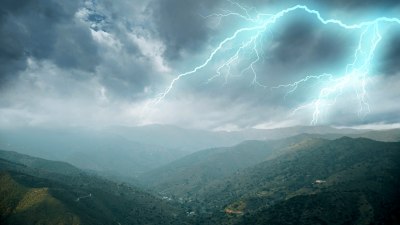The Real Reason the Pacific Ocean Messes With Weather on Three Continents
Explore how the Pacific Ocean influences weather patterns across three continents and its impact on climate.

Image by frimufilms on Freepik
The Pacific Ocean, the largest and deepest ocean on Earth, plays a pivotal role in the planet's climate and weather patterns. This vast body of water affects weather conditions across the Americas, Asia, and Australia, influencing everything from tropical storms to seasonal changes and even droughts. Understanding the connection between the Pacific Ocean and these weather phenomena is crucial for predicting climate changes and preparing for extreme weather events.
The Pacific Ocean’s Size and Impact
The Pacific Ocean covers more than 63 million square miles, accounting for over one-third of the Earth's surface. Its immense size means it can store and transport vast amounts of heat and moisture. The ocean’s surface temperature fluctuations can lead to significant changes in atmospheric circulation patterns. For instance, the phenomenon known as El Niño involves periodic warming of the ocean surface in the central and eastern Pacific, profoundly affecting weather patterns along the coasts of North and South America, and leading to disruptions in global climate.
Understanding El Niño and La Niña
El Niño and its counterpart La Niña represent two extremes of the Pacific Ocean’s climate variability. El Niño occurs when warm water accumulates in the central and eastern tropical Pacific, while La Niña is characterized by cooler than average sea surface temperatures in the same region. These variations significantly alter global weather patterns, impacting precipitation, temperature, and storm activity across continents.
During an El Niño event, areas of the western coasts of North and South America may experience increased rainfall and a higher frequency of storms. Conversely, regions such as Southeast Asia and Australia can suffer from drought and reduced rainfall. These shifts in weather are not just local; they can send ripples through global weather systems, affecting agriculture, water supply, and even energy production.
Effects on North America
The effects of the Pacific Ocean on North America are particularly pronounced. During El Niño events, the pattern of jet streams changes, resulting in wetter winters in the southern United States and drier conditions in the Pacific Northwest and Northern Plains. This is because the warm waters shift the storm tracks and alter wind patterns, leading to significant weather anomalies.
The western U.S. may receive excessive precipitation, leading to flooding, landslides, and other related calamities. On the other hand, the Midwest may encounter drought-like conditions, affecting agriculture and water supplies.
Influence on South America
South America is equally impacted by fluctuations in the Pacific. Countries along the western coast, such as Peru and Ecuador, experience dramatic changes in their weather patterns during El Niño. The warming ocean waters lead to increased rainfall, which can result in devastating mudslides and flooding. Marine biodiversity, too, suffers during these events as warmer waters disrupt fishing patterns and habitats.
In contrast, La Niña typically brings about drier conditions and a decrease in rainfall in these areas. The consequences of these climate variations are dire for local economies that rely on agriculture and fishing.
Effects on Asia and Australia
The Asian region, particularly Southeast Asia and Australia, faces significant weather changes as a result of the Pacific Ocean dynamics. El Niño is associated with increased tropical cyclone activity in the west Pacific and can lead to drought conditions across Australia. This has far-reaching implications for the agricultural sector as reduced rainfall impacts crop yields and water resources.
Conversely, La Niña often produces wetter conditions in Australia, leading to excessive rainfall and a heightened risk of floods. The variations also affect typhoon activity in the northwest Pacific, potentially increasing the number and intensity of storms that make landfall in Asia.
The Role of Climate Change
Climate change further complicates these interactions between the Pacific Ocean and global weather. As ocean temperatures continue to rise, the frequency and intensity of El Niño and La Niña events may also increase. Research suggests that climate change could lead to more extreme weather patterns, resulting in unforeseen consequences for agriculture, infrastructure, and communities across continents.
Moreover, the melting polar ice caps influence ocean currents and sea levels, further altering weather patterns. This underscores the importance of understanding the complex relationships between the Pacific Ocean and the climate in developing strategies to mitigate and adapt to climate-related issues.
Predicting Weather Patterns
Accurate weather predictions are essential, and understanding the role of the Pacific Ocean is crucial for meteorologists. Satellite technology and climate models are increasingly utilized to monitor sea surface temperatures and predict how changes in the Pacific will affect weather patterns globally.
Early warnings of El Niño or La Niña can help governments and organizations implement preparedness measures to mitigate potential impacts. Predictive modeling helps scientists understand the relationships between ocean temperatures and atmospheric conditions, providing valuable insights into future weather events.
The Pacific Ocean is a central player in the intricate dance of global weather patterns, influencing the climate on three continents and beyond. As humanity faces the challenges of climate change, understanding these dynamics becomes crucial for forecasting weather anomalies, developing sustainable practices, and building resilience against extreme weather events.
Through a deeper understanding of the Pacific Ocean's influence, we can better prepare ourselves for the weather challenges of the future. As researchers continue to analyze ocean currents, temperature fluctuations, and their relationships with atmospheric phenomena, society can gain better insights into how to adapt and thrive in changing climatic conditions.











